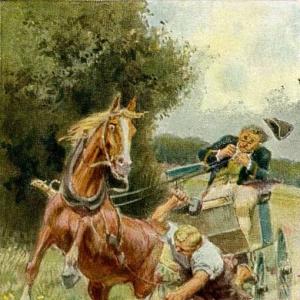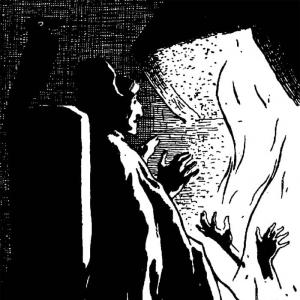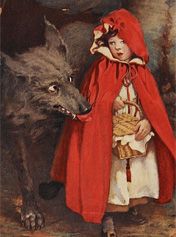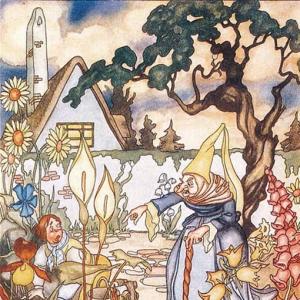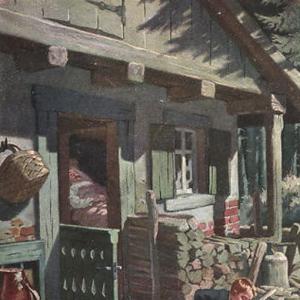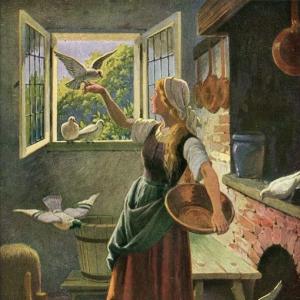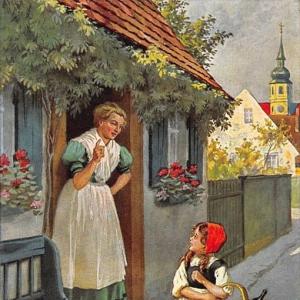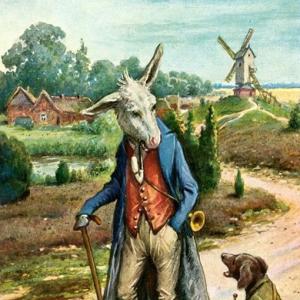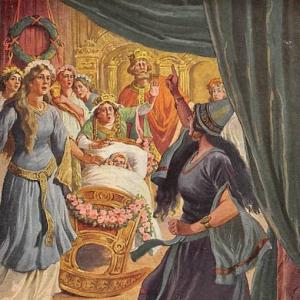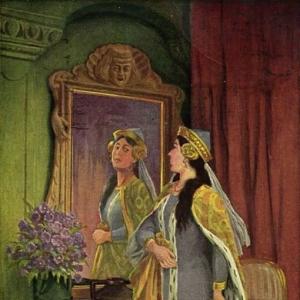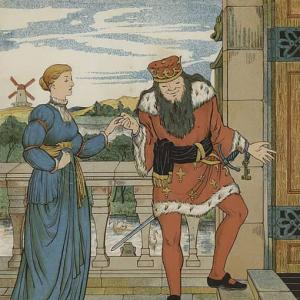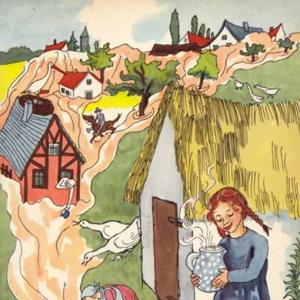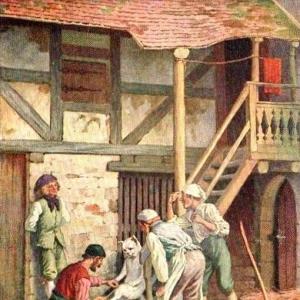Reading time: 7 min
There were two cocks– one on the dung-hill, the other on the roof. They were both arrogant, but which of the two rendered most service? Tell us your opinion– we’ll keep to ours just the same though.
The poultry yard was divided by some planks from another yard in which there was a dung-hill, and on the dung-hill lay and grew a large cucumber which was conscious of being a hot-bed plant.
„One is born to that,“ said the cucumber to itself. „Not all can be born cucumbers. There must be other things, too. The hens, the ducks, and all the animals in the next yard are creatures too. Now I have a great opinion of the yard cock on the plank. He is certainly of much more importance than the weather-cock who is placed so high and can’t even creak, much less crow. The latter has neither hens nor chicks, and only thinks of himself and perspires verdigris. No, the yard cock is really a cock! His step is a dance! His crowing is music, and wherever he goes one knows what a trumpeter is like! If he would only come in here! Even if he ate me up stump, stalk, and all, and I had to dissolve in his body, it would be a happy death,“ said the cucumber.
In the night there was a terrible storm. The hens, chicks, and even the cock sought shelter. The wind tore down the planks between the two yards with a crash. The tiles came tumbling down, but the weather-cock sat firm. He did not even turn round, for he could not; and yet he was young and freshly cast, but prudent and sedate. He had been born old, and did not at all resemble the birds flying in the air– the sparrows, and the swallows; no, he despised them, these mean little piping birds, these common whistlers. He admitted that the pigeons, large and white and shining like mother-of-pearl, looked like a kind of weather-cock; but they were fat and stupid, and all their thoughts and endeavours were directed to filling themselves with food, and besides, they were tiresome things to converse with. The birds of passage had also paid the weather-cock a visit and told him of foreign countries, of airy caravans and robber stories that made one’s hair stand on end. All this was new and interesting. That is, for the first time, but afterwards, as the weather-cock found out, they repeated themselves and always told the same stories, and that’s very tedious, and there was no one with whom one could associate, for one and all were stale and small-minded.
„The world is no good!“ he said. „Everything in it is so stupid.“
The weather-cock was puffed up, and that quality would have made him interesting in the eyes of the cucumber if it had known it, but it had eyes only for the yard cock, who was now in the yard with it.
The wind had blown the planks, but the storm was over.
„What do you think of that crowing?“ said the yard cock to the hens and chickens. „It was a little rough– it wanted elegance.“
And the hens and chickens came up on the dung-hill, and the cock strutted about like a lord.
„Garden plant!“ he said to the cucumber, and in that one word his deep learning showed itself, and it forgot that he was pecking at her and eating it up.
„A happy death!“
The hens and the chickens came, for where one runs the others run too. They clucked, and chirped, and looked at the cock, and were proud that he was of their kind.
„Cock-a-doodle-doo!“ he crowed, „the chickens will grow up into great hens at once, if I cry it out in the poultry-yard of the world!“
And hens and chicks clucked and chirped!
And the cock announced a great piece of news.
„A cock can lay an egg! And do you know what’s in that egg? A basilisk. No one can stand the sight of such a thing; people know that, and now you know it too– you know what is in me, and what a champion of all cocks I am!“
With that the yard cock flapped his wings, made his comb swell up, and crowed again; and they all shuddered, the hens and the little chicks– but they were very proud that one of their number was such a champion of all cocks. They clucked and chirped till the weather-cock heard. He heard it; but he did not stir.
„Everything is very stupid,“ the weather-cock said to himself. „The yard cock lays no eggs, and I am too lazy to do so. If I liked, I could lay a wind-egg. But the world is not worth even a wind-egg. Everything is so stupid! I don’t want to sit here any longer.“
With that the weather-cock broke off; but he did not kill the yard cock, although the hens said that had been his intention. And what is the moral?
„Better to crow than to be puffed up and break off!
 Learn languages. Double-tap on a word.Learn languages in context with Childstories.org and Deepl.com.
Learn languages. Double-tap on a word.Learn languages in context with Childstories.org and Deepl.com.Backgrounds
Interpretations
Adaptions
Summary
Linguistics
„The Farm-yard Cock and the Weather-cock“ is a fairy tale written by Danish author Hans Christian Andersen, who is renowned for his vast collection of fairy tales and stories, including „The Little Mermaid,“ „The Ugly Duckling,“ and „The Emperor’s New Clothes.“ Andersen’s stories are known for their captivating narratives, profound morals, and unique blend of fantasy and reality.
Hans Christian Andersen was born in Odense, Denmark, in 1805 and lived a humble life before achieving fame as a writer. He began publishing his fairy tales in the 1830s, drawing inspiration from folklore, as well as his own experiences and imagination. Andersen’s stories often explore themes of beauty, love, and the triumph of the human spirit, while also examining the darker aspects of human nature, such as greed, pride, and vanity.
„The Farm-yard Cock and the Weather-cock“ was first published in 1854 as part of a collection called „New Fairy Tales. Second Volume. First Collection“ (Nye Eventyr. Andet Bind. Første Samling). The story is lesser-known compared to some of Andersen’s other works but still conveys important messages and themes that are characteristic of his writing.
In this tale, Andersen employs the use of anthropomorphism, imbuing animals and objects with human characteristics, such as the yard cock, the weather-cock, and the cucumber. This technique allows him to explore complex themes and morals in a way that is engaging and accessible to readers of all ages. The story’s vivid imagery and engaging narrative make it a unique and thought-provoking addition to Andersen’s repertoire of fairy tales.
„The Farm-yard Cock and the Weather-cock“ offers several interpretations that can be drawn from the story, exploring themes such as arrogance, pride, self-worth, and the importance of staying grounded.
Arrogance and Pride: Both the yard cock and the weather-cock are portrayed as arrogant characters, each believing they are superior to the other. The yard cock boasts about his abilities and presence, while the weather-cock looks down on other birds and the world in general. This theme cautions readers against arrogance and pride, as both characters are ultimately flawed in their beliefs.
Self-worth and Comparison: The cucumber admires the yard cock, wishing to be part of his world, even at the cost of its own life. This highlights the dangers of seeking validation from others and comparing oneself to others, as it can lead to a loss of self-worth and identity.
The Importance of Staying Grounded: The weather-cock’s detachment from the world below him serves as a metaphor for the danger of losing touch with reality and the people around us. The yard cock, on the other hand, remains connected to the hens and chicks, and as a result, he is admired by them. This theme emphasizes the importance of staying grounded and maintaining connections with others.
Self-expression vs. Detachment: The moral of the story, „Better to crow than to be puffed up and break off,“ encourages self-expression and warns against becoming detached and disdainful. The yard cock’s crowing demonstrates his confidence and ability to express himself, whereas the weather-cock’s detachment leads him to break away from his post. This interpretation suggests that it is better to embrace our strengths and express ourselves rather than becoming aloof and disengaged from the world around us.
In conclusion, „The Farm-yard Cock and the Weather-cock“ presents various interpretations that explore themes such as arrogance, pride, self-worth, and the importance of staying grounded. The story serves as a reminder to embrace our strengths and express ourselves, while also staying connected to others and the world around us.
„The Farm-Yard Cock and the Weather-Cock“ is a classic fairy tale by Hans Christian Andersen that has inspired numerous adaptations and retellings. Here are a few examples.
Animated adaptations: The story has been adapted into several animated films and TV shows, including the 1955 Soviet animated film „The Weather-Vane“ and the 1991 animated TV special „The Emperor’s New Clothes and Other Fairy Tales“ by Rankin/Bass.
Picture books: „The Farm-Yard Cock and the Weather-Cock“ has been adapted into several picture books, including versions by Eric Carle and Paul Galdone.
Plays and musicals: The story has also been adapted into stage plays and musicals, such as the 2015 children’s musical „The Farmyard Cock and the Weathercock“ by composer Alexander L’Estrange.
Variations and retellings: The basic plot and themes of the story have been used in various adaptations and retellings, including „The Rooster Who Wanted to Fly“ by Barbara Gregorich and „The Crow and the Pitcher“ by Aesop.
Parodies and humorous adaptations: The story has been parodied and adapted in humorous ways, such as the 2017 YouTube video „The Farm-Yard Cock and the Weather-Cock (In the Style of Edgar Allan Poe)“ by Benvolio Music Productions.
Overall, „The Farm-Yard Cock and the Weather-Cock“ is a versatile story that has inspired a wide range of adaptations in various mediums and styles.
„The Farm-yard Cock and the Weather-cock“ is a fairy tale by Hans Christian Andersen that tells the story of two arrogant cocks – one living in a farmyard and the other atop a roof as a weather-cock. The tale starts with a cucumber in a dung-hill, admiring the yard cock for his lively presence and wishing to be a part of his world, even at the cost of its own life.
One night, a violent storm damages the farm, tearing down the planks between the yards and breaking tiles from the roof. The weather-cock, though young and newly cast, remains unmoved, showing his prudence and sense of superiority over other birds. He finds the pigeons, sparrows, and swallows beneath him and only tolerates the tales of adventure from the birds of passage. However, he quickly becomes bored with their repetitive stories and starts to view the world as dull and uninteresting.
After the storm, the yard cock, along with the hens and chicks, enters the cucumber’s yard. The cucumber is overjoyed when the yard cock addresses it as a „garden plant“ and does not mind being eaten by him. The yard cock continues to boast about his abilities, announcing that he can lay an egg containing a basilisk – a creature so deadly that no one can withstand its gaze. The hens and chicks are in awe of the yard cock’s claim, and their admiration reaches the weather-cock.
Frustrated by the mundane world and feeling too lazy to lay even a wind-egg, the weather-cock decides to break off from his post, leaving the yard cock unharmed. The tale concludes with a moral: „Better to crow than to be puffed up and break off,“ reminding readers that it is better to be confident and express oneself than to become detached and disdainful.
„The Farm-yard Cock and the Weather-cock“ by Hans Christian Andersen is a fairy tale ripe for linguistic analysis, offering several layers of meaning through its characters and their dialogues.
Here are some key elements to consider:
Character Representation and Symbolism
The Yard Cock: Represents pride, self-importance, and vanity. Linguistically, the cock’s portrayal comes through in phrases like „strutted about like a lord“ and his grand proclamations („Cock-a-doodle-doo!“). His speech is boastful and flamboyant, emphasizing sound (crowing) and physical presence (strutting).
The Weather-cock: Embodies indifference, pessimism, and introspection. Its language reflects a sense of superiority and disdain, using words like “puffed up,” and phrases like „everything is so stupid. “ The weather-cock’s reflection seems ironic; its position, though high, is passive and stagnant.
Language and Tone
– Andersen uses contrasting tones to differentiate between the characters. The yard cock’s language is vibrant, self-aggrandizing, and public, creating a communal atmosphere among the hens and chicks. Conversely, the weather-cock’s tone is morose, introspective, and dismissive, highlighting its isolation despite its elevated position.
Moral and Irony
– Andersen employs irony to convey the story’s moral. The yard cock is celebrated for claims of achievements it cannot accomplish, like laying an egg containing a basilisk, which is biologically impossible. The weather-cock recognizes this absurdity yet is equally trapped by its own limitations.
The tale culminates in an ironic twist: while the yard cock is full of bluster and false achievements, it is the weather-cock, with its practicality and wisdom, that could endure real-world calamites. Yet, it breaks off, unable to find meaning or value in its existence, echoing existential sentiments.
Dialogue and Diction
– The dialogue is deliberate and character-specific. The yard cock’s language is repetitive and exuberant, using simple diction that reflects its audience—hens, chicks, and the naïve cucumber. The weather-cock’s soliloquy reflects a cynical worldview, with language that is both dismissive and detached, using words like “stupid” and metaphors like “wind-egg” to denote emptiness and futility.
Figurative Language
Metaphors and Similes: The cucumber’s comparison of the yard cock to a trumpeter enriches the text with imagery that reflects admiration and aspiration.
Personification: In giving human-like thoughts and feelings to a cucumber, Andersen accentuates the theme of misplaced admiration and value.
Conclusion
„The Farm-yard Cock and the Weather-cock“ is a rich text for linguistic exploration, where Andersen ingeniously uses language to differentiate characters, incorporate irony, and enforce the story’s moral lessons. Through the interplay of pride, vanity, and cynicism, Andersen critiques societal values and the meaning individuals pursue in their perceived roles.
Information for scientific analysis
Fairy tale statistics | Value |
|---|---|
| Translations | DE, EN, DA, ES, FR, IT |
| Readability Index by Björnsson | 26 |
| Flesch-Reading-Ease Index | 87.6 |
| Flesch–Kincaid Grade-Level | 4.7 |
| Gunning Fog Index | 7.7 |
| Coleman–Liau Index | 7.4 |
| SMOG Index | 8 |
| Automated Readability Index | 4.5 |
| Character Count | 4.573 |
| Letter Count | 3.466 |
| Sentence Count | 60 |
| Word Count | 878 |
| Average Words per Sentence | 14,63 |
| Words with more than 6 letters | 100 |
| Percentage of long words | 11.4% |
| Number of Syllables | 1.083 |
| Average Syllables per Word | 1,23 |
| Words with three Syllables | 41 |
| Percentage Words with three Syllables | 4.7% |

 Facebook
Facebook  Whatsapp
Whatsapp  Messenger
Messenger  Telegram
Telegram Reddit
Reddit
